2023 CADILLAC LYRIC airbag off
[x] Cancel search: airbag offPage 73 of 424

Cadillac Lyriq Owner Manual (GMNA-Localizing-U.S./Canada-15644413) -
2023 - CRC - 2/23/22
72 Seats and Restraints
In addition, the vehicle has a
passenger sensing system for
the front outboard passenger
position, which includes
sensors that are part of the
passenger seat. The
passenger sensing system
may not operate properly if
the original seat trim is
replaced with non-GM covers,
upholstery, or trim; or with GM
covers, upholstery, or trim
designed for a different
vehicle. Any object, such as an
aftermarket seat heater or a
comfort-enhancing pad or
device, installed under or on
top of the seat fabric, could
also interfere with the
operation of the passenger
sensing system. This could
either prevent proper
deployment of the passenger
airbag(s) or prevent the
passenger sensing system
from properly turning off the
passenger airbag(s). See
Passenger Sensing System
066. If the vehicle has rollover
roof-rail airbags, see Different
Size Tires and Wheels
0352
for additional important
information.
If the vehicle must be modified
because you have a disability
and have questions about
whether the modifications will
affect the vehicle's airbag
system, or if you have
questions about whether the
airbag system will be affected
if the vehicle is modified for
any other reason, call
Customer Assistance. See
Customer Assistance Offices
0 386.
Airbag System Check
The airbag system does not
need regularly scheduled
maintenance or replacement.
Make sure the airbag
readiness light is working. See
Airbag Readiness Light 0112.
Caution
If an airbag covering is
damaged, opened, or broken,
the airbag may not work
properly. Do not open or
break the airbag coverings.
If there are any opened or
broken airbag coverings,
have the airbag covering
and/or airbag module
replaced. For the location of
the airbags, see Where Are
the Airbags? 061. See your
dealer for service.
Replacing Airbag
System Parts after a
Crash
{Warning
A crash can damage the
airbag systems in the
vehicle. A damaged airbag
system may not properly
protect you and your
passenger(s) in a crash,
(Continued)
Page 80 of 424
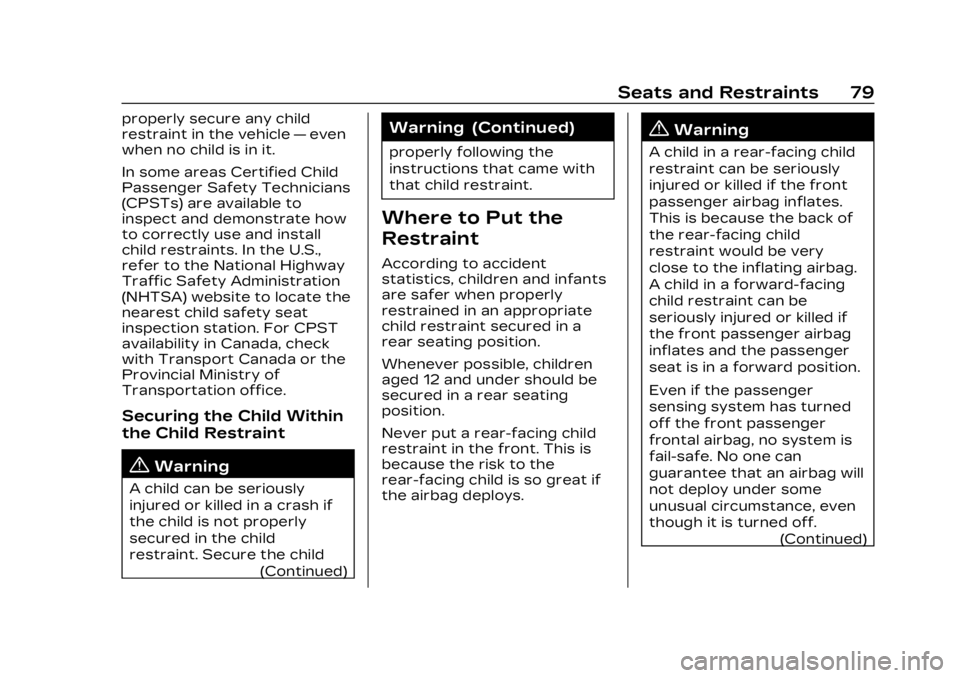
Cadillac Lyriq Owner Manual (GMNA-Localizing-U.S./Canada-15644413) -
2023 - CRC - 2/23/22
Seats and Restraints 79
properly secure any child
restraint in the vehicle—even
when no child is in it.
In some areas Certified Child
Passenger Safety Technicians
(CPSTs) are available to
inspect and demonstrate how
to correctly use and install
child restraints. In the U.S.,
refer to the National Highway
Traffic Safety Administration
(NHTSA) website to locate the
nearest child safety seat
inspection station. For CPST
availability in Canada, check
with Transport Canada or the
Provincial Ministry of
Transportation office.
Securing the Child Within
the Child Restraint
{Warning
A child can be seriously
injured or killed in a crash if
the child is not properly
secured in the child
restraint. Secure the child
(Continued)
Warning (Continued)
properly following the
instructions that came with
that child restraint.
Where to Put the
Restraint
According to accident
statistics, children and infants
are safer when properly
restrained in an appropriate
child restraint secured in a
rear seating position.
Whenever possible, children
aged 12 and under should be
secured in a rear seating
position.
Never put a rear-facing child
restraint in the front. This is
because the risk to the
rear-facing child is so great if
the airbag deploys.
{Warning
A child in a rear-facing child
restraint can be seriously
injured or killed if the front
passenger airbag inflates.
This is because the back of
the rear-facing child
restraint would be very
close to the inflating airbag.
A child in a forward-facing
child restraint can be
seriously injured or killed if
the front passenger airbag
inflates and the passenger
seat is in a forward position.
Even if the passenger
sensing system has turned
off the front passenger
frontal airbag, no system is
fail-safe. No one can
guarantee that an airbag will
not deploy under some
unusual circumstance, even
though it is turned off.(Continued)
Page 81 of 424
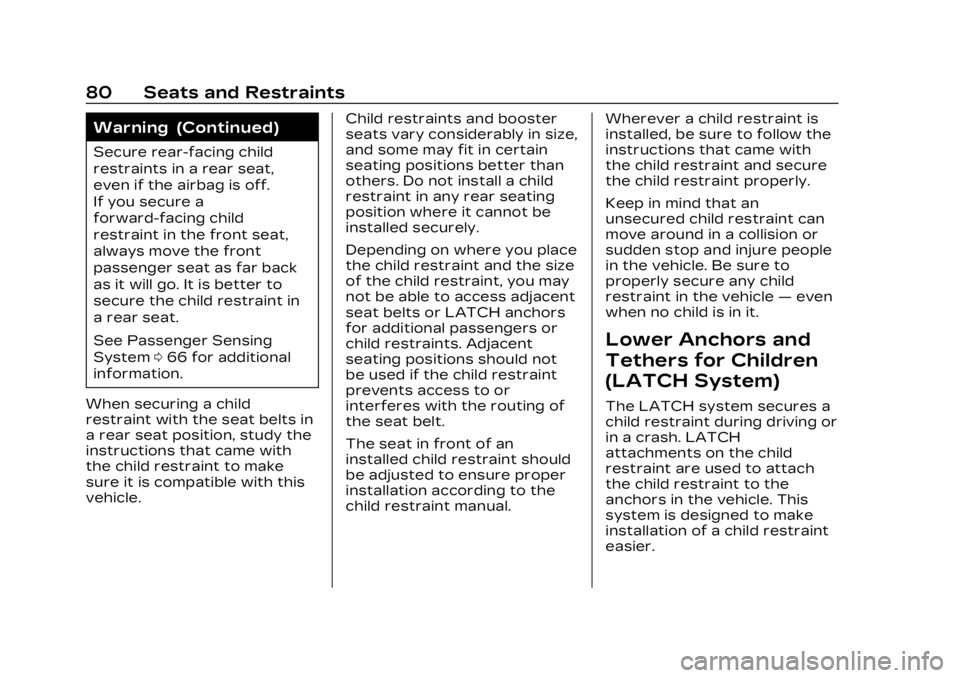
Cadillac Lyriq Owner Manual (GMNA-Localizing-U.S./Canada-15644413) -
2023 - CRC - 2/23/22
80 Seats and Restraints
Warning (Continued)
Secure rear-facing child
restraints in a rear seat,
even if the airbag is off.
If you secure a
forward-facing child
restraint in the front seat,
always move the front
passenger seat as far back
as it will go. It is better to
secure the child restraint in
a rear seat.
See Passenger Sensing
System066 for additional
information.
When securing a child
restraint with the seat belts in
a rear seat position, study the
instructions that came with
the child restraint to make
sure it is compatible with this
vehicle. Child restraints and booster
seats vary considerably in size,
and some may fit in certain
seating positions better than
others. Do not install a child
restraint in any rear seating
position where it cannot be
installed securely.
Depending on where you place
the child restraint and the size
of the child restraint, you may
not be able to access adjacent
seat belts or LATCH anchors
for additional passengers or
child restraints. Adjacent
seating positions should not
be used if the child restraint
prevents access to or
interferes with the routing of
the seat belt.
The seat in front of an
installed child restraint should
be adjusted to ensure proper
installation according to the
child restraint manual.Wherever a child restraint is
installed, be sure to follow the
instructions that came with
the child restraint and secure
the child restraint properly.
Keep in mind that an
unsecured child restraint can
move around in a collision or
sudden stop and injure people
in the vehicle. Be sure to
properly secure any child
restraint in the vehicle
—even
when no child is in it.
Lower Anchors and
Tethers for Children
(LATCH System)
The LATCH system secures a
child restraint during driving or
in a crash. LATCH
attachments on the child
restraint are used to attach
the child restraint to the
anchors in the vehicle. This
system is designed to make
installation of a child restraint
easier.
Page 91 of 424
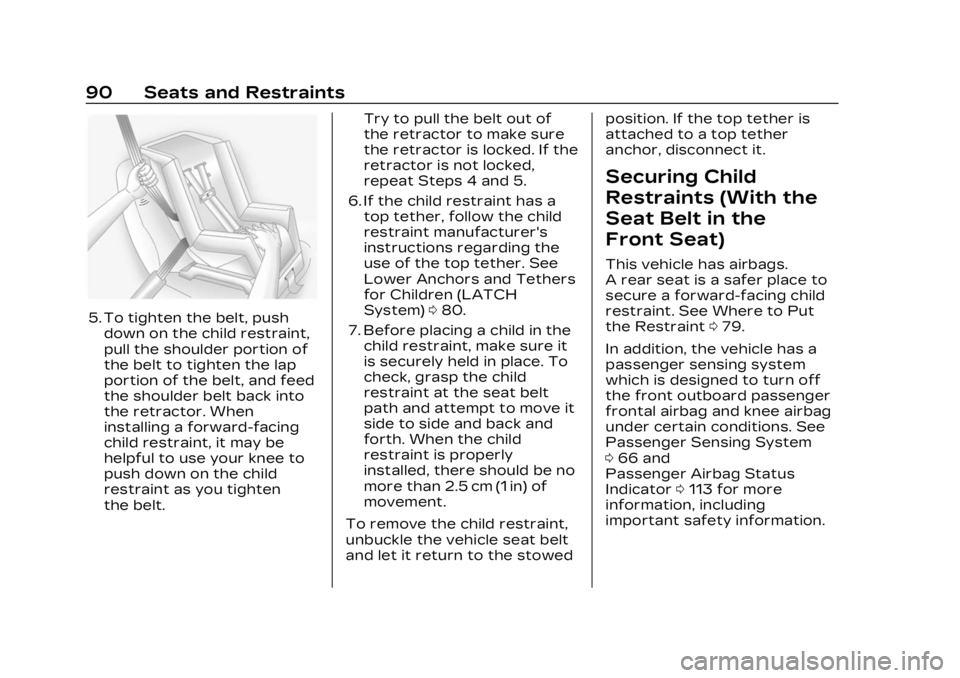
Cadillac Lyriq Owner Manual (GMNA-Localizing-U.S./Canada-15644413) -
2023 - CRC - 2/23/22
90 Seats and Restraints
5. To tighten the belt, pushdown on the child restraint,
pull the shoulder portion of
the belt to tighten the lap
portion of the belt, and feed
the shoulder belt back into
the retractor. When
installing a forward-facing
child restraint, it may be
helpful to use your knee to
push down on the child
restraint as you tighten
the belt. Try to pull the belt out of
the retractor to make sure
the retractor is locked. If the
retractor is not locked,
repeat Steps 4 and 5.
6. If the child restraint has a top tether, follow the child
restraint manufacturer's
instructions regarding the
use of the top tether. See
Lower Anchors and Tethers
for Children (LATCH
System) 080.
7. Before placing a child in the child restraint, make sure it
is securely held in place. To
check, grasp the child
restraint at the seat belt
path and attempt to move it
side to side and back and
forth. When the child
restraint is properly
installed, there should be no
more than 2.5 cm (1 in) of
movement.
To remove the child restraint,
unbuckle the vehicle seat belt
and let it return to the stowed position. If the top tether is
attached to a top tether
anchor, disconnect it.
Securing Child
Restraints (With the
Seat Belt in the
Front Seat)
This vehicle has airbags.
A rear seat is a safer place to
secure a forward-facing child
restraint. See Where to Put
the Restraint
079.
In addition, the vehicle has a
passenger sensing system
which is designed to turn off
the front outboard passenger
frontal airbag and knee airbag
under certain conditions. See
Passenger Sensing System
0 66 and
Passenger Airbag Status
Indicator 0113 for more
information, including
important safety information.
Page 92 of 424
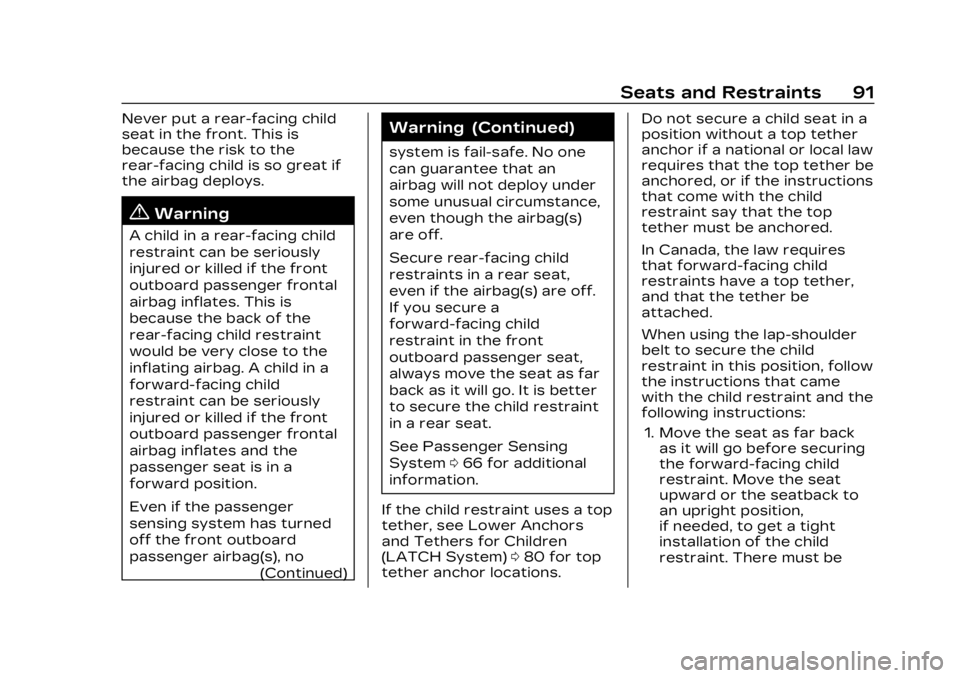
Cadillac Lyriq Owner Manual (GMNA-Localizing-U.S./Canada-15644413) -
2023 - CRC - 2/23/22
Seats and Restraints 91
Never put a rear-facing child
seat in the front. This is
because the risk to the
rear-facing child is so great if
the airbag deploys.
{Warning
A child in a rear-facing child
restraint can be seriously
injured or killed if the front
outboard passenger frontal
airbag inflates. This is
because the back of the
rear-facing child restraint
would be very close to the
inflating airbag. A child in a
forward-facing child
restraint can be seriously
injured or killed if the front
outboard passenger frontal
airbag inflates and the
passenger seat is in a
forward position.
Even if the passenger
sensing system has turned
off the front outboard
passenger airbag(s), no(Continued)
Warning (Continued)
system is fail-safe. No one
can guarantee that an
airbag will not deploy under
some unusual circumstance,
even though the airbag(s)
are off.
Secure rear-facing child
restraints in a rear seat,
even if the airbag(s) are off.
If you secure a
forward-facing child
restraint in the front
outboard passenger seat,
always move the seat as far
back as it will go. It is better
to secure the child restraint
in a rear seat.
See Passenger Sensing
System066 for additional
information.
If the child restraint uses a top
tether, see Lower Anchors
and Tethers for Children
(LATCH System) 080 for top
tether anchor locations. Do not secure a child seat in a
position without a top tether
anchor if a national or local law
requires that the top tether be
anchored, or if the instructions
that come with the child
restraint say that the top
tether must be anchored.
In Canada, the law requires
that forward-facing child
restraints have a top tether,
and that the tether be
attached.
When using the lap-shoulder
belt to secure the child
restraint in this position, follow
the instructions that came
with the child restraint and the
following instructions:
1. Move the seat as far back as it will go before securing
the forward-facing child
restraint. Move the seat
upward or the seatback to
an upright position,
if needed, to get a tight
installation of the child
restraint. There must be
Page 93 of 424
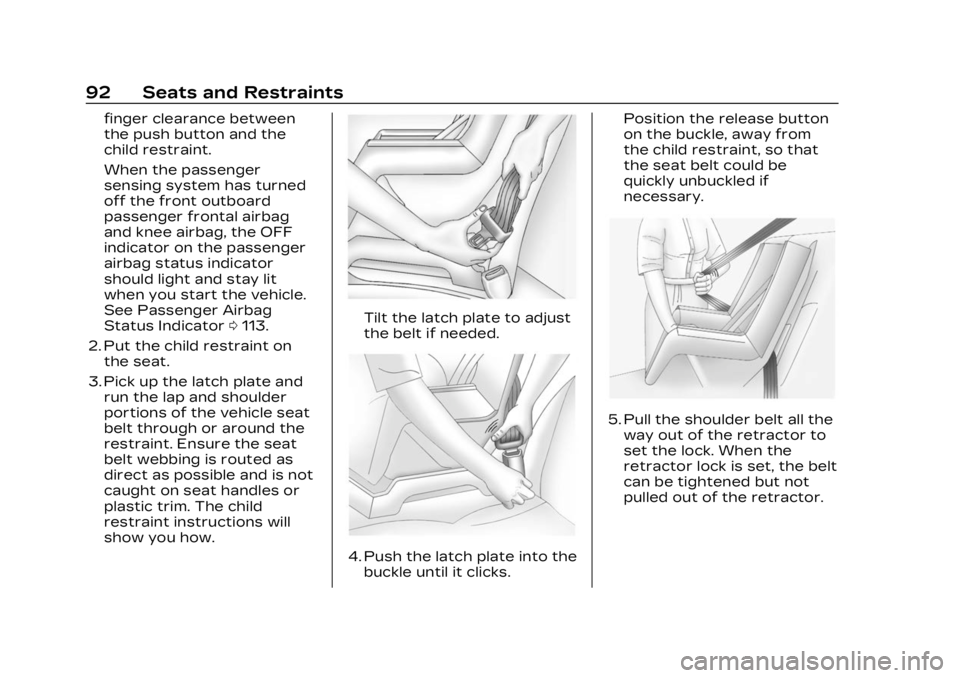
Cadillac Lyriq Owner Manual (GMNA-Localizing-U.S./Canada-15644413) -
2023 - CRC - 2/23/22
92 Seats and Restraints
finger clearance between
the push button and the
child restraint.
When the passenger
sensing system has turned
off the front outboard
passenger frontal airbag
and knee airbag, the OFF
indicator on the passenger
airbag status indicator
should light and stay lit
when you start the vehicle.
See Passenger Airbag
Status Indicator0113.
2. Put the child restraint on the seat.
3. Pick up the latch plate and run the lap and shoulder
portions of the vehicle seat
belt through or around the
restraint. Ensure the seat
belt webbing is routed as
direct as possible and is not
caught on seat handles or
plastic trim. The child
restraint instructions will
show you how.
Tilt the latch plate to adjust
the belt if needed.
4. Push the latch plate into thebuckle until it clicks. Position the release button
on the buckle, away from
the child restraint, so that
the seat belt could be
quickly unbuckled if
necessary.
5. Pull the shoulder belt all the
way out of the retractor to
set the lock. When the
retractor lock is set, the belt
can be tightened but not
pulled out of the retractor.
Page 94 of 424
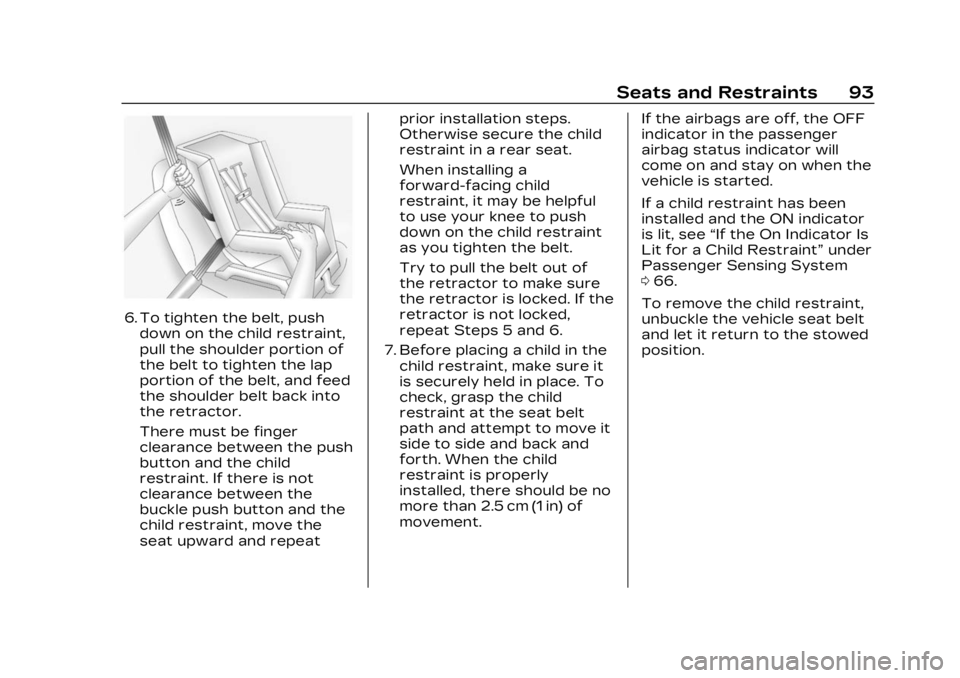
Cadillac Lyriq Owner Manual (GMNA-Localizing-U.S./Canada-15644413) -
2023 - CRC - 2/23/22
Seats and Restraints 93
6. To tighten the belt, pushdown on the child restraint,
pull the shoulder portion of
the belt to tighten the lap
portion of the belt, and feed
the shoulder belt back into
the retractor.
There must be finger
clearance between the push
button and the child
restraint. If there is not
clearance between the
buckle push button and the
child restraint, move the
seat upward and repeat prior installation steps.
Otherwise secure the child
restraint in a rear seat.
When installing a
forward-facing child
restraint, it may be helpful
to use your knee to push
down on the child restraint
as you tighten the belt.
Try to pull the belt out of
the retractor to make sure
the retractor is locked. If the
retractor is not locked,
repeat Steps 5 and 6.
7. Before placing a child in the child restraint, make sure it
is securely held in place. To
check, grasp the child
restraint at the seat belt
path and attempt to move it
side to side and back and
forth. When the child
restraint is properly
installed, there should be no
more than 2.5 cm (1 in) of
movement. If the airbags are off, the OFF
indicator in the passenger
airbag status indicator will
come on and stay on when the
vehicle is started.
If a child restraint has been
installed and the ON indicator
is lit, see
“If the On Indicator Is
Lit for a Child Restraint” under
Passenger Sensing System
0 66.
To remove the child restraint,
unbuckle the vehicle seat belt
and let it return to the stowed
position.
Page 99 of 424

Cadillac Lyriq Owner Manual (GMNA-Localizing-U.S./Canada-15644413) -
2023 - CRC - 2/23/22
98 Instruments and Controls
Instruments and
Controls
Controls
Steering WheelAdjustment . . . . . . . . . . . . . . . . . . 99
Heated Steering Wheel . . . 99
Horn . . . . . . . . . . . . . . . . . . . . . . . . . . . 100
Pedestrian Safety Signal . . . . . . . . . . . . . . . . . . . . . . . . 100
Windshield Wiper/ Washer . . . . . . . . . . . . . . . . . . . . . 100
Compass . . . . . . . . . . . . . . . . . . . . . 102
Clock . . . . . . . . . . . . . . . . . . . . . . . . . . . 102
Power Outlets . . . . . . . . . . . . . . 102
Wireless Charging . . . . . . . . . 104
Warning Lights, Gauges,
and Indicators
Warning Lights, Gauges, and Indicators . . . . . . . . . . . . . 108
Instrument Cluster . . . . . . . . 108
Speedometer . . . . . . . . . . . . . . . . 110
Odometer . . . . . . . . . . . . . . . . . . . . . 110
Trip Odometer . . . . . . . . . . . . . . 110
Battery Gauge (High Voltage) . . . . . . . . . . . . . . . . . . . . . 110
Power Indicator Gauge . . . . 111
Seat Belt Reminders . . . . . . . 112 Airbag Readiness Light . . . 112
Passenger Airbag Status
Indicator . . . . . . . . . . . . . . . . . . . . . 113
Charging System Light (12-Volt Battery) . . . . . . . . . . . 114
Low State of Charge Light . . . . . . . . . . . . . . . . . . . . . . . . . . 114
Charge Cord Connected Light . . . . . . . . . . . . . . . . . . . . . . . . . . 114
Battery Fault Light . . . . . . . . . 115
Propulsion Power is Limited Light . . . . . . . . . . . . . . . 115
Service Vehicle Soon Light . . . . . . . . . . . . . . . . . . . . . . . . . . 115
Brake System Warning Light . . . . . . . . . . . . . . . . . . . . . . . . . . 115
Electric Parking Brake Light . . . . . . . . . . . . . . . . . . . . . . . . . . 116
Service Electric Parking Brake Light . . . . . . . . . . . . . . . . . 116
Antilock Brake System (ABS) Warning Light . . . . . 117
Automatic Vehicle Hold (AVH) Light . . . . . . . . . . . . . . . . . . 117
Lane Keep Assist (LKA) Light . . . . . . . . . . . . . . . . . . . . . . . . . . 117
Automatic Emergency Braking (AEB) Disabled
Light . . . . . . . . . . . . . . . . . . . . . . . . . . 118 Vehicle Ahead
Indicator . . . . . . . . . . . . . . . . . . . . . 118
Pedestrian Ahead Indicator . . . . . . . . . . . . . . . . . . . . . 118
Traction Off Light . . . . . . . . . . 119
StabiliTrak OFF Light . . . . . 119
Traction Control System
(TCS)/StabiliTrak
Light . . . . . . . . . . . . . . . . . . . . . . . . . . 119
Driver Mode Control Light . . . . . . . . . . . . . . . . . . . . . . . . . 120
Tire Pressure Light . . . . . . . 120
Security Light . . . . . . . . . . . . . . . 121
Vehicle Ready Light . . . . . . . . 121
One-Pedal Driving Light . . . . . . . . . . . . . . . . . . . . . . . . . . 121
High-Beam On Light . . . . . . . 121
Lamps On Reminder . . . . . . 122
Cruise Control Light . . . . . . 122
Door Ajar Light . . . . . . . . . . . . . 122Information Displays
Charging . . . . . . . . . . . . . . . . . . . . . . 123
Driver Information Center (DIC) . . . . . . . . . . . . . . . . 132
Vehicle Information . . . . . . . . 133
Vehicle Messages
Vehicle Messages . . . . . . . . . 134
Propulsion Power Messages . . . . . . . . . . . . . . . . . . . 135